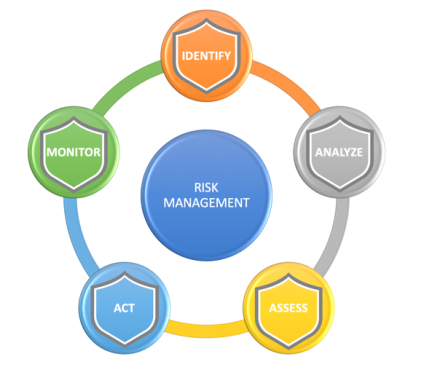In my last two columns, I discussed a survey that revealed how policies and procedures regarding electrical storms vary among aquatics facilities. Some even appear to adopt conflicting approaches to managing the lightning risk. With conflicting recommendations coming from established safety organizations, such variances are understandable.
To help individual operators develop the best policies for their facilities, this article proposes a standard risk-management analysis. Additionally, I address three areas where I saw concerning survey results: monitoring of storm events, warning of storm events, and facility closures.

Courtesy Shawn DeRosa
Risk Management Process
Many businesses employ a common risk-management analysis, charted on the next page. It consists of five steps, which I’ll explain and apply to electrical storm management:
Identify the risk. What risks do lightning storms present? Lightning can strike anywhere, injuring patrons or staff, or causing damage to the building or equipment. Lightning can cause glass windows to shatter and bricks to be blown free from a building exterior. A lightning surge can travel through wires and damage equipment, such as pool pumps, chemical controllers, computers and telephones. Persons touching this equipment at the time of a lightning strike can be injured or killed.
Analyze the probability and impact. Ask yourself, “What is the probability of a lightning strike at this facility?” The more frequently that thunderstorms occur in your area, the higher probability that a strike will take place. Some states, such as Florida, have a high lightning risk whereas other areas present a lower frequency.
Another question to consider: “What is the potential impact of a strike?” Because a lightning strike could result in death, severe injury, and/or significant damage to a facility, most experts would agree that the impact analysis would yield a finding of “severe impact.”
Assess management options. Using the Impact vs. Probability analysis charted on the next page, consider what level of risk management is needed. The higher the frequency of occurrence and the greater the impact, the more managers must do to manage the risk. Also, consider the level of risk tolerance within your organization. Use the chart on the following page to guide you in this assessment.
Take action. After determining the level of management required, consider the specific steps needed to adequately manage the risk at requisite level of care. Policies and procedures, staff training, warning signs, waivers of liability, emergency drills and the like may all be required based upon your analysis. While it is helpful to benchmark how other facilities do this, it is important to document your own analysis as your facility may differ from others.
Monitor implementation. Policies and procedures are always a work in progress. Always ask yourself several questions when implementing them. Are procedures clear? Does staff fully comply? Do any of the procedures or policies fail to work as well as anticipated? As part of the risk-management process, once new concerns are noted, the process starts all over again.
Courtesy Shawn DeRosa
Risk Assessment Example: Diving Into Shallow Water
It may be helpful to consider how you manage other risks. Look at the practice of diving into shallow water. In analyzing how often you expect people to attempt this, you may find a “Medium Frequency” — it may not happen every day, but likely on a regular basis. Now, what is the impact of striking the bottom of the pool? Death or permanent catastrophic injury would require a finding of “Severe Impact.” In aligning a Medium Frequency with Severe Impact, you find that significant management of this risk is required.
With this combination, consider all the actions taken to manage the risk of patrons diving into shallow water. Posted water depth markings and “no diving” signs and symbols are standard. Some centers include a “No Diving Zone” stripe along the entire perimeter of shallow-water areas. Lifeguards remain alert and provide warnings to patrons they suspect may dive into shallow water. Swimming instructors teach students not to dive in water less than 9 feet deep. Diving blocks are moved to deeper water, and their use is often restricted to instructional or swim-team use only.
Application to lightning events
The frequency of a lightning strike at or near your facility is something to carefully consider. Is the center located where lightning is common? If so, this may place the frequency at Medium to High. If strikes are rare, you may assess the probability as Low. This question is critical, as it defines the level of management needed, given that the impact of a lightning strike is generally severe.
While no one factor alone determines the best course of action, closure of indoor pools may be the most appropriate management option in areas where lightning is a high frequency / severe impact event. The option to stay open indoors is more likely to be suitable where lightning is assessed as a low frequency/severe impact event, or at facilities where additional protections such as lightning suppression systems are in place.
Cures for Troubling trends
The results of my survey exposed three particularly troubling trends regarding electrical-storm practices. Let’s look at best practices to which operators should aspire in these areas.
Monitoring of storm events: While a majority of surveyed pool operators (65%) now utilize technology to manage electrical-storm risks, a lingering reliance on traditional methods of managing lightning risks remains. This is exemplified by the percentage of outdoor pool operators who use technology to track incoming storms but still wait to see lightning or hear thunder before removing swimmers from the water.
Having a designated storm watcher and monitoring storm activity with cell phone apps and other technologies has become a best practice and is quickly becoming a standard of care. The storm watcher should not rely exclusively on technology. Remaining observant of environmental conditions and taking action whenever thunder is heard is more important than waiting for an alert from a storm tracking device.
Regardless of the technology used, advance warning allows more time to shepherd patrons to a safe location before a storm gets dangerously close. This becomes particularly important at special events where hundreds of participants and spectators could be placed at risk. Similarly, tracking the storm as it moves past a venue may allow facilities to re-open sooner than the traditional 30-minute wait past the last crash of thunder or flash of lightning.
Notice and warning: It became clear that, in the case of an impending storm, many facilities will provide notice at check-in of the potential for storm activity (i.e., a storm watch). But this is not the same as warning of a specific incoming storm (i.e., a storm warning). Specific warnings of incoming storms were not given at nearly half of the aquatics facilities surveyed.
As a best practice, warn patrons of specific storm activity, particularly in cases where swimmers are allowed to remain in the water. Use of technology is required to accomplish this. Waiting to hear thunder or see lightning is akin to waiting for the storm to be upon you. Facility managers would be well-advised to be proactive and not wait for the storm to come within striking distance before taking action.
Best practices would allow enough time for persons to move completely inside a sheltering location before the storm reaches 6 to 10 miles from the facility. Lightning is known to strike up to 10 miles in front of a storm, making it important for persons to be in a safe location before the storm reaches that distance.
It is unclear whether U.S. law requires facility operators to provide warnings of storm activity. Older cases, typically involving golf courses, indicate that thunder is a sufficient warning unto itself. Some courts have held that lightning is not predictable and thus it is nearly impossible to provide an effective warning. Other courts have held that lightning is an Act of God, requiring no warning.
But with technology evolving, it is reasonable to expect that the law will evolve as well. As lightning-detection systems, paid subscription services and mobile apps become less expensive and more widely used, the standard of care may shift. This may be particularly important indoors, where it is more difficult to detect thunder or see lightning.
Facility closures: Aquatics facilities must consider safety risks to patrons upon closing the pool and removing swimmers from the water.
At outdoor pools, the standard of care is to close facilities during storms and advise patrons to seek shelter in a substantial building (with plumbing and electrical wiring) or personal vehicles. Allowing patrons to remain on the deck, under shade structures, or in bathhouses poses a risk, as they provide little protection from strikes. Your Lightning Safety Plan should identify sheltering locations. If adequate shelter is not available, advanced warning becomes even more important, as it provides ample time to move to a safe location.
Among indoor pools surveyed, the majority stay open during thunderstorms, even though many operators don’t know if the pools are properly bonded or grounded, or even when the last electrical inspection took place. This poses a concern, as the option to stay open runs counter to the conservative recommendations of virtually all safety organizations. The American Red Cross, the YMCA of the USA, and the National Lightning Safety Institute each recommend that indoor pools close during electrical storms due to the possibility of a fatality or mass casualty event.
Yet aquatics facility managers deal with the possibility of catastrophic injuries daily, including fatal drowning, severe spinal injuries and deadly chemical leaks that can affect everyone in the pool area. In a risk analysis, what matters most is the probability of an event, not the mere possibility. We do not close facilities because of the mere possibility of a drowning, a spinal injury or even a chemical leak. Instead, we remain open and carefully manage these risks.
As I reported previously, there is little, if any, evidence of lightning-related fatalities to indoor pool users. Data from the National Weather Service and reviews of news articles could not identify one. Of the 376 lightning-related deaths identified by NWS since 2006, 99.5% occurred outdoors. Only two occurred indoors, one to a teenager near a window and the second to a male speaking on a corded phone. But the risk becomes magnified when you consider injuries as well: For every fatal strike, it is estimated seven non-fatal strikes occur.
Even if you decide to keep your indoor facility open during an electrical storm, I’d recommend that your Lightning Safety Plan still require warnings to patrons, empowering them to decide whether to continue swimming or seek shelter. Your plan should also require guests and staff to avoid contact with showers, water faucets, corded telephones, computers and metallic objects, as well as staying clear of large glass windows and open doors. And it is strongly advised that you caution guests to remain indoors, as leaving the facility during a thunderstorm may put them at elevated risk of injury.
The decision to stay open indoors during a thunderstorm should take into consideration a variety of factors, including but not limited to the duration and severity of storm activity, frequency of electrical inspections, building structural materials, presence of lightning protection systems, your agency’s level of risk tolerance, and availability of sheltering locations. Involving your risk management office, environmental health and safety department, insurer and/or legal counsel in the development of the plan is also recommended.
